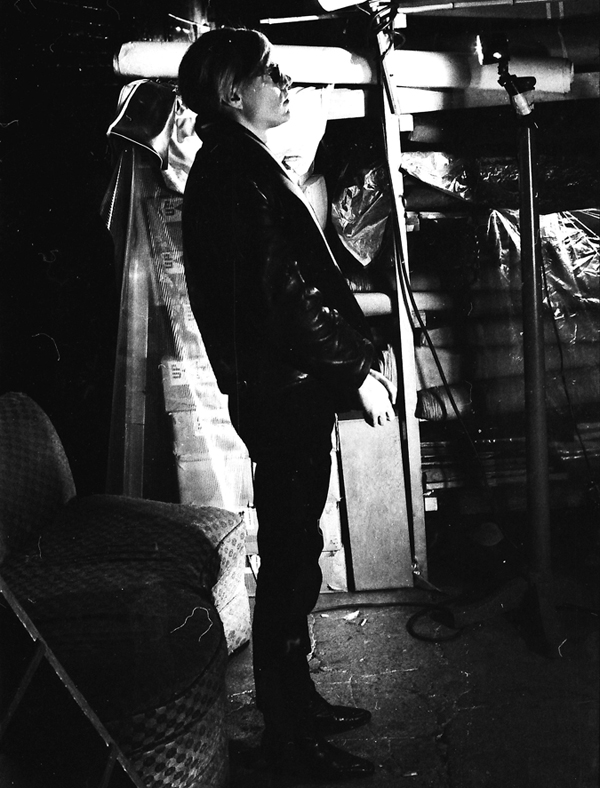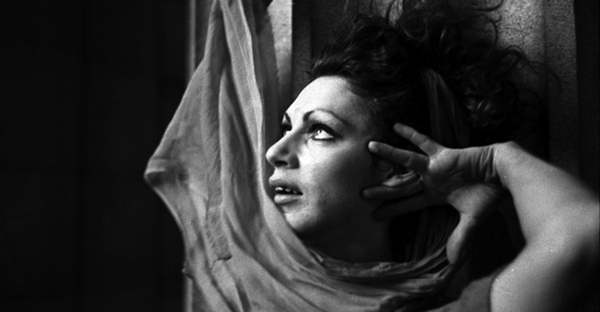
“Everyone will be famous for 15 minutes.” 2014 marked the 50th Anniversary of the Silver Factory and that expression, of which even Warhol had tired, claiming, “I’m bored with that line.” Our Factory People thought so too, except for Ultra Violet, who had cleverly entitled her memoir: ‘Famous For 15 Minutes.’ This did not endear her to other writers with ties to the Factory, who would have killed for it. Anyway, once again, we incorporated intros for this last episode of the TV series. Though most of our filmed subjects were familiar by now, new characters were constantly being added to further flavor the simmering Silver Factory stew. Unfortunately, as with any favorite dish, too many cooks in the kitchen can ultimately destroy it …
* * *
Warhol was looking for, not so much for extraordinary ideas, but things that had never been done, so why not do a film for twenty-four hours?
—Ultra Violet (1935–2014): Socialite, Artist, Warhol Superstar
There are very few (paintings) left … He seems to prefer filmmaking to art.
—Leo Castelli (1907–1999): Famed Art Dealer, and Gallery Owner, interviewed in 1968
The only acting experience I got with Andy was impersonating him, by request, on college tours. And these people knew nothing about Warhol.
—Allen Midgette: Actor, Warhol Superstar
He was the one who had the guts to save the Velvet Underground from poverty and misery.
—Nico (1938–1988): Warhol Icon, Velvet Underground Star
They hated the music. They couldn’t get past the one track. I had one engineer that said, “They don’t pay me enough to listen to this shit.”
—Lou Reed (1942–2013): Rock Legend, Founder, Velvet Underground
Everyone’s jumping ship. Edie wasn’t there anymore, and by spring of ’67, the Velvets weren’t there anymore.
—Gerard Malanga: Warhol Factory ‘Prime Minister,’ Poet
Andy came to La Jolla, California, when he was shooting ‘San Diego Surf,’ and the police could hardly wait to bust him.
—Vincent Fremont: Founding Director, Andy Warhol Foundation for the Visual Arts
The last movie we made was ‘San Diego Surf,’ and on the plane back, Andy said I would be next Superstar. Two days after we got back he was shot.
—Taylor Mead (1924–2013): Poet, Downtown Personality, Warhol Star
People were stealing his work left and right. We even knew them! I didn’t know what to do, because I was afraid.
—David Croland: Publisher LID Magazine, young member Warhol ‘family’
Edie was getting too stoned to do anything. The dealers had a lot to do with it. Edie was losing her sense of balance. She couldn’t even stand up without tipping over. At the end there, it was very sad.
—Danny Fields: Edie Sedgwick Confidant, Music Entrepreneur (The Ramones)
Warhol really fucked up a great many young people’s lives. I was a good target. I bloomed into a healthy young drug addict.
—Edie Sedgwick (1943–1971): Warhol Icon, Girl of the Year, 1965
Edie had burned down her apartment (at the Chelsea Hotel). She left candles everywhere, and they burned down her place, and that era was over.
—Bibbe Hansen: Warhol Actress, Youngest Member of Warhol family
I knew Andy was mad at me, because he doesn’t like to give anyone money. That’s not true—he would give these crazy transvestites a hundred dollars once in a while, but me, no. We weren’t paid.
—Mary Woronov: Writer, Artist, Actress, Warhol Star
Jackie (Curtis) devised this plan: “Why don’t we just go to Max’s (Kansas City) and sign Andy’s name …” And Andy got all the bills.
—Holly Woodlawn, aka Harold Ajzenberg: Drag Queen, Warhol Superstar (‘Flesh,’ ‘Trash’)
I was born beautiful, and I will die beautiful!
—Jackie Curtis, née Curtis Holder (1947–1985) Warhol’s ‘Superstar in a Housedress’
I’m only a woman … only a facade.
—Candy Darling, née James Slattery (1944–1974): Drag Queen, Superstar (‘Women In Revolt’)
These pioneer female impersonators were so gifted, and so funny, and had such a hard time, making very little money.
—Paul Morrissey: Warhol Co-Director, Filmmaker, ‘Women in Revolt’
They would put on five pairs at least, of false eyelashes at the same time, so when they blinked their eyes it was awnings going up and down!
—‘Leee’ Black Childers (1945–2014): Factory Acolyte, Photographer, Former Mgr. David Bowie

“Only a facade.” In the pale light of dawn, Holly Woodlawn could almost convince as a 1940s Grecian goddess. (Photo: ‘Leee’ Black Childers)

Triptych of Ivy Nicholson, in her fabulously flimsy underwear. The truculent star of ‘I, A Man’ shares a small room, barely, with Tom Baker. (Photo: Billy Name)
When I left, Andy said he had to replace me with drag queens. Well, Paul didn’t want me around. I had a fiery temper. I almost broke the camera in ‘I, A Man.’
—Ivy Nicholson: Warhol Superstar
After I saw ‘I, A Man,’ I went up to Andy and demanded to be in the next movie.
—Viva: Warhol Superstar, Artist
Oh, people like Viva, (mimicking) “He owes me money; he never paid me!”
—Brigid Berlin: Warhol Muse, Movie Character and Confidante
In ‘Flesh,’ I was going to be married to Joe Dallesandro and have this lesbian girlfriend. I improvised it all … Andy loved to collect colorful characters that had something special about them.
—Geraldine Smith: Warhol Star (‘Flesh,’ ‘Trash’), one of ‘Andy’s kids’
Andy asked me to do pictures for ‘Interview’ Magazine. Max’s back room was like a studio. I could just sit there and shoot. These people had a radiance about them. I didn’t have to use a flash; they would just light up the picture.
—Anton Perich: Photographer, Filmmaker, Painter
I was in the dark room, I heard a bang, and there was Andy lying in a pool of blood. He got shot because Valerie (Solanas) said he was available.
—Billy Name: Warhol Photographer, Factory Foreman, ‘Gate-keeper’
Well, you know how Valerie got there, don’t you? I said, “I will call Andy and tell him that you have an interesting script for him.”
—Nat Finkelstein (1933–2009): Photojournalist, Black Star Agency, Warhol Chronicler, ’64–’67
I never saw (Valerie) personally, but there were many people in his circle, in his film world. He was dealing with curious and eccentric subject matter.
—Ivan Karp (1926–2012): Longtime Warhol Art Dealer
50-50 at this stage. There is a team upstairs … operating.
—Chief of Surgery, Columbus Hospital, 1968
Andy said, “I died, Louis. The light at the end of the tunnel went out.”
—Louis Waldon (1934–2013): Actor, ‘Artist,’ Warhol Star
He wouldn’t fall asleep until dawn cracked, because if you fall asleep at night you’re not quite sure of waking up again … Andy probably has his own idea about Hell.
—Henry Geldzahler (1935–1994): Art Critic, Curator, Metropolitan Museum of Art

“There are no rules …” The Velvet Underground recording “one of the 10 most influential albums of all time.” Lou Reed, who helped shape rock for 50 years, died in 2013. (Photo: Nat Finkelstein)

Busy, busy Ultra Violet (“They are blind, blind in the art world.”) meets with uber art dealer Leo Castelli. 50 years later, in May of 2014, aristocratic Ultra (aka Mlle. Isabelle Collin Dufresne), had her 15 minutes, with her own Pop art retrospective at the Dillon gallery in Chelsea. (Photo: Billy Name)
Andy was at the cutting edge of the age that we live in now. We will not want our fifteen minutes of fame. We’ll pay dearly for our anonymity.
—Robert Heide: Playwright, Warhol Confidant
Later, newspapers said, “Oh, he destroyed people; some of them committed suicide.” No, no! Maybe the only happy moments they had were in the Factory.
—Jonas Mekas: Founder, Film-Makers’ Cinematheque, Anthology Film Archives
Don’t pay any attention to what they write about you. Just measure it in inches.
—Andy Warhol
* * *
Because Warhol deliberately obscured his origins, few outside of academic circles know that his family came from Ruthenia, in the Carpathian Mountains near the borders of Russia and Poland, which happens to be the home of the real Count Dracula, otherwise known as ‘Vladimir the Impaler.’ Ondine bestowed on Warhol the endearing name of ‘Drella,’ a combination of Dracula and Cinderella. Lou Reed wrote ‘Songs for Drella’ in tribute. Everyone wore black and favored the nightlife. Warhol evidently related to his family’s infamous neighbor. One of his early (’64) movies, the aforementioned funfest known as ‘Batman/Dracula’ starred influential camp filmmaker Jack Smith as the Count, with his group of thespians, along with Warhol’s people, which included Naomi Levine, Baby Jane Holzer, Mario Montez (also a Smith star), Gerard Malanga, Taylor Mead, Robert Heide, Allen Midgette, Henry Geldzahler, Philip Fagan, Rufus Collins, Ivy Nicholson, and Darius de Polean, her son by a French Viscount. Whew! No wonder I didn’t list them before! The film, which took months to make, was endless and often grueling to watch, with moments of erotic brilliance, but our blood had long since been siphoned out of us. ‘Batman/Dracula’ was never released, so thank you, Warhol Museum, for that singular experience … Going over our own footage, I wondered if we would ever get our film released, either. We had too much material! By the time we’d reached the end of our exhaustive interviews, and our exhausted interviewees, we’d sensed a note of melancholy stealing into the amusing anecdotes and titillating oft-told tales. Warhol’s former confidants and co-workers, boyfriends and beauty queens, were coming once again to the end of their time with the man who had, for better or worse, changed their lives forever. Though some would be considered damaged goods, for a brief moment in history, the Factory Family had been lucky enough to have lived, as Ivy remembers, “a fairy tale period.” Others were not so charitable, blaming Warhol for the escalating mental meltdowns. But as Lou Reed once stated, “The Factory is not a mental hospital.” So no one, least of all Warhol, was about to help the floundering souls who found themselves losing touch with reality.